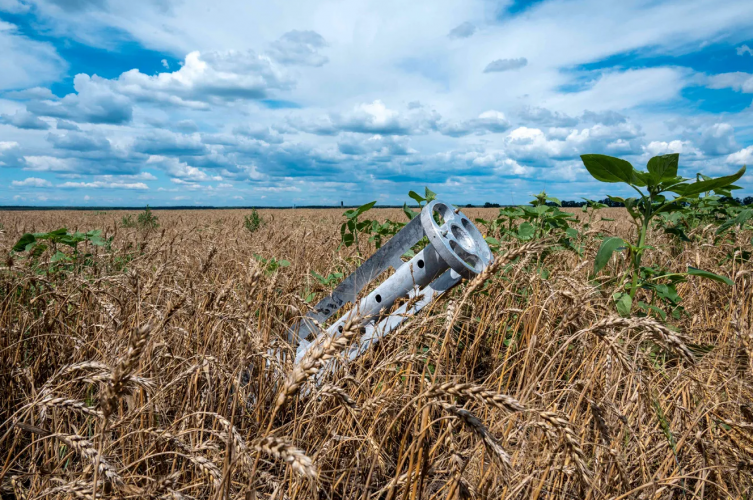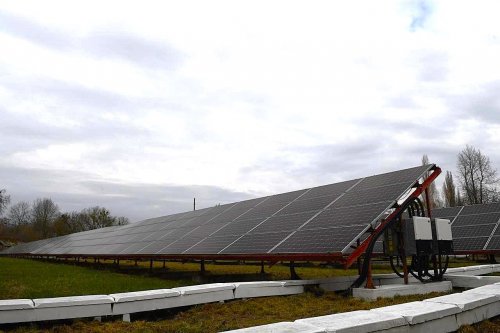In Ukraine, since the beginning of the full-scale war, more than 2,000 crimes against nature by the russian occupiers have already been recorded, and the amount of damages has already reached 204 billion hryvnias.
The government is preparing lawsuits in international courts to bring the aggressor country to justice for every fact of ecocrime, reports Ministry of Environment.
"In fact, we are doing something that no one in the world has done before us. We have developed 10 new methods for calculating the damage caused to the environment, – said the head of the Ministry of Environment, Ruslan Strilets. – These developments are of global importance. Russia is the main ecoterrorist today. If the world does not understand this in time, Ukraine will have to share its methods with other countries."
Threats to nuclear and radiation safety
Capture by russian troops Zaporizhzhia NPP and placing military equipment there is a manifestation of nuclear terrorism and poses a threat to the entire world. In Energodar, the russian military kidnapped about a hundred workers of the Zaporizhzhia NPP they captured. In captivity, people are tortured, and only a few of them return to work at the station.
The russian military dragged at least 14 units of heavy military equipment with ammunition, weapons and explosives to the engine room of the 1st power unit of the ZNNP, which has been inactive since the start of hostilities. However, there are fuel materials and military equipment, which is dangerous because it can be a source of fire. Also, entrances for fire engines, which could put out such a fire in case of such a fire, are completely blocked.
"Currently, there is a double threat to nuclear safety: the fact that there are additional sources for the fire in the engine room and the fact that it will not be possible to extinguish it later," the material said.
IN Exclusion zones of the Chernobyl NPP work continues to eliminate the consequences of the occupation by russian troops.
The research group of the Greenpeace organization, which cooperates with Ukrainian scientists in Chernobyl, discovered , that the level of radiation in the areas where the russian military was entrenched was at least three times higher than the International Atomic Energy Agency (IAEA) estimate made in April.
At a russian camp near Yaniv railway station, the Greenpeace team measured dose rates ranging from 0.18 µSv/h (microsieverts per hour) to 2.5 µSv/h at a height of 10 cm. The highest level is more than three times the IAEA estimate. At an intersection 1.5 km from the former Russian checkpoint near the Red Forest, the dose rate was 7.7 µSv/h – much higher than the IAEA measured.
In samples that were measured in a mobile laboratory in the field, it showed a sharp contrast in Cs-137 concentrations ranging from 45,000 Bq/kg to below 500 Bq/kg. Violation of soil layers by the russian army can both bring to the surface slightly contaminated soil from deeper layers and more contaminated soil from other layers. This can lead to a higher level of migration of radionuclides into the environment.
Also, measurements using a special drone show even higher radiation levels in a wider area to the south. About 200 imps (impulses per second) were recorded over the russian camp, while 600-700 meters to the south the highest activity was almost 8,000 imps, 40 times higher.
The Greenpeace investigative group also documented the fact that the russian military's destruction or damage to key laboratories, databases, and radiation monitoring systems caused serious damage to the scientific infrastructure of the Chernobyl Nuclear Power Plant. In particular, it is about damage to laboratory equipment necessary for studying the effects of radiation on people and the environment, which threatens the safety of current and future generations.
On July 25, the international organizations Conflict and Environment Observatory and Zoï Environment Network published a detailed independent report on the radiation risks caused by the russian invasion of Ukraine. The report is also based on satellite data.
According to the report, there is an urgent need to restore the infrastructure and team of specialists to ensure security in the Exclusion Zone. The prerequisite for further assessment of the damage caused by the Russian occupation should be the survey and demining of the territory.
Attacks on infrastructure and industrial facilities
July 21:
- shelled Avdiivka, Bakhmut, Kostiantynivka, Soledar, Siversk, Kramatorsk, Shcherbynivka, and New York in the Donetsk region. 19 civilian objects, including a butter production facility and 3 factories, were destroyed;
- carried out 57 shellings from MSLRs and 8 rocket attacks on Mykolaiv, destroying a car wash and an enterprise. Two Russian rockets hit the humanitarian aid warehouse, containing supplies for children and the elderly. The warehouse completely burned in a large-scale fire.
On July 22, the occupiers launched 28 strikes on 17 settlements in the Donetsk region. 58 civilian objects were destroyed and damaged, including a market, a drinking water tank, a farm, a plant nursery, and a gas distribution pipe.
July 23:
- launched a missile attack on Mykolaiv. As a result, there were 3 large-scale fires on an area of 7,000 square meters in the Korabelnyi district;
- carried out a missile attack on an airfield and a railway infrastructure facility in the Kirovohrad region;
- shelled Lozivskyi, Kharkivskyi, Chuguyivskyi, Izyumskyi, and Bogodukhivskyi districts of the Kharkiv region. As a result of the shelling, fires broke out in industrial production buildings. In the city of Balaklia, a landfill caught fire due to shelling;
- damaged the gas pipeline and electricity grid in the Shyrokivska community, the Dnipropetrovsk region.
On July 24, the occupiers again shelled Mykolaiv, hitting a private warehouse and the territory of several private enterprises. Enterprise buildings were hit and destroyed. A fire broke out in one of the buildings.
July 25:
- launched a missile attack on the territory of an agricultural enterprise in Lyubymivka, the Dnipropetrovsk region. The hayloft, pig farm, and granary were damaged;
- shelled the "Artemsil" enterprise in the city of Soledar, the Donetsk region. As a result of the attack, the warehouse building caught fire. Firefighters extinguished the fire a few hours after the shelling.
July 26:
- launched a missile attack on an enterprise and a critical infrastructure facility in Mykolaiv;
- carried out a missile attack on the Slobidsky district of Kharkiv. As a result of the shelling, an industrial enterprise and a car dealership building were damaged;
- shelled Zolochiv, Tsyrkuny, and Andriyivka in the Kharkiv region, damaging infrastructure facilities, the premises of an agricultural enterprise, and an experimental workshop for the repair and manufacture of oil and gas equipment.
July 27:
- shelled Mykolaiv, hitting an industrial zone and a repair enterprise;
- shelled the Avdiivka coke plant in the Donetsk region;
- destroyed a critical infrastructure facility in the Industrial District in Kharkiv.
During the week, fierce battles took place on the territory of the Vuhlehirsk TPP in the Donetsk region.
Large-scale fires at infrastructure and industrial facilities lead to air poisoning by particularly dangerous substances. Pollutants can be carried by winds over long distances.
Pollution directly caused by hostilities
According to Ukraine’s State Emergency Service (SES), from 24 February to 27 July 2022, 167,953 explosive devices, including 2,095 aircraft bombs, were neutralized in Ukraine. An area of 66 651 hectares was surveyed for explosives.
Destroyed military equipment and ammunition, as well as exploded missiles and air bombs, pollute the soil and groundwater with chemicals, including heavy metals.
Shelling and fires in cities lead to toxic emissions into the air, which affects everyone who is near the place of impact and the resulting fire. Such damage can have a long-term effect and even lead to chemical poisoning. After the fire has been extinguished and a site of fire dries out, it turns into a secondary source of ash emissions, including toxic ones. Any wind can lift ashes into the air again.
Pity the nature reserves and protected ecosystems
In the Luhansk region, as a result of fires caused by the actions of Russian troops, 28,000 hectares of forests, mainly coniferous, were damaged. The forests around the cities of Severodonetsk, Rubizhne and Kreminna were the most affected. During the war, at least 70% of the forest plantations of the Starokrasnian Forestry and at least 60% of the forest plantations of the Borovenkiv Forestry were damaged. Also, significant damage was caused to the flora of the Kremin Forests National Park. Forest fire monitoring was tracked using satellite data from the FIRMS system from NASA.
On July 22, as a result of Russian shelling, a forest fire broke out on the territory of Halytsynivska TG, Mykolaiv region. Extinguishing forest fires is complicated by hostilities and minefields in forest areas.
According to Minagro, domestic animals in Ukraine die not only directly from active hostilities, but also from limited physical access to farms, limited opportunities to purchase fodder and provide veterinary services. The estimated number of animals that died as a result of Russian aggression in the affected areas is 42,000 sheep and goats, 92,000 cattle, 258,000 pigs and more than 5.7 million poultry.
Damage to water resources
Russian troops are carrying out targeted strikes on the infrastructure for the intake, purification and supply of water, as well as sewage treatment facilities.
On July 24, due to hostilities, power was cut off at the Karlivsk filter station in the Donetsk region.
Due to Russian aggression, water supply and drainage facilities in Luhansk, Donetsk, Zaporizhzhia, Kharkiv and Mykolaiv regions were significantly damaged.
Black and Azov seas
As a result of the war, serious threats to the environment arose in the Black and Azov Seas: in particular, mining and explosions, oil and fuel spills, coastal fires, and the spread of infectious disease agents.
Russian forces are attacking infrastructure along the coasts of the Black and Azov seas and ships at anchorages, leading to water pollution and the spread of toxins into the sea.
On July 23, Russian troops launched a missile attack on the Odesa sea trade port. The attack led to a fire, and the pumping station was damaged. The missile strike took place the day after the multilateral agreement on unblocking grain exports from Ukraine was signed in Istanbul under the auspices of the UN.
On July 26, Russian troops launched a missile attack on Zatoka, Odesa region. As a result of the attack on civilian objects, 5 residential buildings were destroyed, more than 15 recreation centers were damaged, and part of the resort settlement turned into a fire.
The national zoological reserve "Snake Island" in the Black Sea suffered significant damage due to military operations. Before the war, Snake Island was the most remote and probably the cleanest corner of the Ukrainian land.
Earlier, EcoPolitic wrote, that experts believe that minimum two generations of Ukrainians will feel harm, caused to nature by military operations due to soil, air and water pollution, which can cause serious diseases, including oncology.
As EcoPolitic previously reported, in Kharkiv, shelling by russian troops of the national scientific center "Kharkiv Physical and Technical Institute" caused damage to the environment in the amount of more than UAH 14.8 billion.





